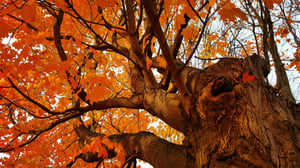 If you’re like me, you take pride in how your lawn looks during spring and summer. Proper lawn maintenance during the growing months includes cutting, trimming, watering, and fertilizing.
If you’re like me, you take pride in how your lawn looks during spring and summer. Proper lawn maintenance during the growing months includes cutting, trimming, watering, and fertilizing.
What about when fall approaches? Do you still maintain your lawn the same way or do you think your lawn needs less care? If you feel your lawn needs less maintenance in the fall, you’re wrong.
I interviewed Marv Wolf, former West Bend’s grounds supervisor for this blog. Marv was responsible for planning, coordinating, and maintaining our 160-acre corporate campus. This includes 50 acres of restored prairie, 2 acres of restored wetlands, 10 acres of restored woodlands, and 3 miles of walking trails.
Here are Marv’s tips on how to take care of your lawn this fall.
Q: Keeping your lawn longer during the summer months has many advantages. During the fall months, should you maintain a longer length or cut it shorter?
A: Our area's recommended grass length is 3 – 3 1/2 inches. Keeping grass longer during the growing season promotes a healthier lawn; however, reducing the length is a good idea as the grass-growing season ends.
The benefits of having a shorter lawn for winter are:
1. It may prevent meadow voles. Meadow voles like to bury in longer grass and can cause damage during the winter months. If you keep your lawn shorter, they may not take up winter residence in your yard.
2. The weight of snow can push down the grass and cause disease. If your lawn is shorter, you can minimize the risk of disease.
Remember, you don’t want to shorten the length of your grass all at once. Slightly lower your blade for the first cut and then drop it again for the final cut, taking off no more than a 1/3 of your current height. Removing too much turf at once can cause undue stress on your lawn.
Q: What is the purpose of lawn aeration and should it be done every year?
A: The soil under your lawn compacts over time, minimizing air space. Minimized air space makes it more difficult for water and nutrients to enter the soil. Core aeration is the process of removing plugs of soil, resulting in many holes in your lawn. There are several benefits to this process:
1. As the soil plugs break down, beneficial enzymes return to the soil.
2. The holes in your lawn make it easier for water, light, and nutrients to get into the soil, promoting deeper root growth.
3. These enzymes also help break down thatch in your lawn. Too much thatch in your lawn prevents water and nutrients from getting into the soil. If you’ve never had your lawn thatched, it’s an excellent idea to thatch and aerate.
The best time of year to core aerate is in late spring or early fall when the grass is actively growing. Depending on how your lawn responds, you may only need to do it every other year.
Q: If I have bare spots in my yard, should I take care of them now or wait until spring?
A: This is a perfect time of year to fix bare spots in your lawn. All you have to do is roughen up the soil with a garden rake and apply your grass seed. Then water the spot(s) every other day for a couple of weeks.
Q: Should I fertilize my lawn anymore this year or wait until next year?
A: Fertilization is crucial because it adds essential nutrients to the soil, promoting healthy growth. Marv recommends fertilizing your lawn three times yearly: on Memorial Day, Labor Day, and Halloween (or after the lawn has gone dormant).
The Labor Day treatment is vital because weeds and grass fight for the soil's nutrients as the fall season progresses. When you apply a fertilizer with a herbicide, nutrients are absorbed in the soil while the herbicide kills off the weeds.
Finally, if you’re only going to do one treatment a year, Marv recommends doing it around Halloween. A fall application provides essential nutrients that promote deep-root growth and provide a nutrient boost. This nutrient boost can help jump-start your yard the following spring.
So that you know, the ground should not be frozen when your last fertilizer treatment is applied because the fertilizer will not be able to get into the soil.
Q: Should I continue watering my lawn and trees?
A: If your lawn is actively growing, you should continue to water it. You can discontinue watering after you cut your lawn for the last time.
As for the trees, if you’re experiencing a dry fall season, you should continue to water them. Evergreens should be watered until the ground freezes. The more water that goes into the root system now, the better the tree will do during winter.
Evergreens transpire during the winter months. Winter months that are sunny but extremely windy and cold can cause the needles to turn brown.
In Wisconsin, the average date for the first frost is October 22. Frost that settles into the ground and doesn’t come out usually occurs mid-to-late November.
Do you have any suggestions or information you’d like to share? I’d love to hear from you. Please share them in the box below.





